Ultimate Ice Fishing Beginners Guide
UPDATED 18 MAY 2023
by Robert Ceran
If you’re new to ice fishing, chances are you have a lot of questions about getting started.
In this ice fishing beginners guide we’ll cover the basics of the sport, and we’ll go over the following topics in detail:
- Ice fishing basics for beginners
- Essential ice fishing gear for beginners
- Rods and reels for ice fishing
- Ice fishing bait
- How to get started
- Tips for the most important species
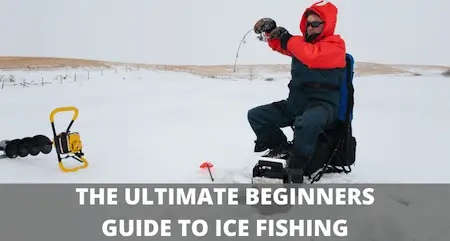
Ice fishing for beginners
Many people assume that ice fishing is complicated and requires lots of expensive gear, but this is far from the truth. You can start out simple with a few essential pieces of gear, and catch plenty of fish even without a huge amount of experience, and at a relatively modest cost.
Ice fishing basics for beginners
We’ll cover the most important ice fishing gear for beginners in a lot more detail below, plus we’ll recommend the best fishing tackle to get you started.
Once you have the right gear and tackle, you also need to learn a few safety guidelines, to make sure you stay safe on the ice. The first rule of hardwater fishing is that you should never go out alone. In fact, If you’re going out on the ice for the first time, it’s best to go with a local guide who can show you the ropes.
In general, you should wait until the ice is at least 4 inches thick before you walk on it. Since ice thickness can vary a lot on the same lake, drill holes regularly as you go, to make sure it’s always thick enough. The thickest ice is usually found at the edge of a lake, so expect it to get thinner as you move towards the center. Ice thickness can also be affected by sunken trees, or by water currents under the ice.
When the ice reaches a thickness of 8 inches, it’s okay to drive on it with an ATV or similar sized vehicle, and once it reaches 12 inches, it can support cars and small trucks, as well as full sized ice houses that are towed into position.
Types of fish to target as an ice fishing beginner
In principle, you can catch any kind of fish during the winter that you can catch in the same lake during summer. But some species are more active in winter, and these are more likely to take your bait. Because of this, most ice anglers focus on the following species:
- Crappie
- Bluegill
- Perch
- Rainbow trout
- Brown trout
- Lake trout
- Walleye
- Northern pike
In addition to the species above, you can also run into bass (both largemouth and smallmouth), sunfish, catfish, sturgeon, burbot, and muskie, but these species are rarely targeted directly, and instead tend to show up as a surprise catch when you’re fishing for other species.
Essential ice fishing gear for beginners
Since this is an ice fishing beginners guide, we’ll only cover the essential equipment here. These are gear items that you absolutely need as a beginner, while omitting the more advanced or non-essential items.
We define ice fishing gear as the equipment that helps you get set up on the ice, and distinguish this from the actual fishing tackle, which we’ll discuss separately in the next section.
While there is a long list of different ice fishing gear items that can potentially be helpful for beginners, the essential items you absolutely need to bring along are just a few.
Ice fishing gear list:
- Warm clothing
- Ice auger
- Sled
- Ice scoop
- Five gallon bucket
- Spud bar
Let’s take a more detailed look at each of these in turn.
Warm clothing
This one should be obvious, since you will be going out in freezing cold temperatures. Also, you can expect to remain seated for long periods of time, which means you need extra warm clothing to keep yourself warm. It’s best to dress with multiple layers, starting with thermal underwear, and adding layers from there.
Ice auger
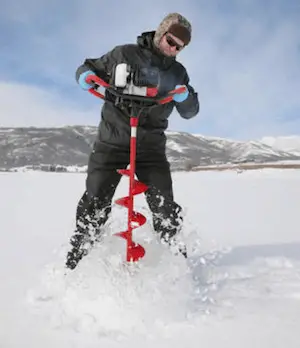
An auger is absolutely essential to drill holes in the ice. While you can potentially do this with a pick axe, an ice auger is a lot easier to handle, and drills holes more precisely, and without making a huge amount of noise to scare the fish off.
You can choose between a hand auger, an electric ice auger, and a gas powered ice auger. In terms of pros and cons between these three options, the manual auger is obviously a lot cheaper, but requires a lot more physical energy to operate.
If you drill more than 10 holes over the course of a day, this starts to become a real problem, and you would be much better off with an electric or gas ice auger. However, if you’re just getting started with ice fishing, a manual auger is absolutely fine.
Finally, you can also convert a manual auger to an electric ice auger by attaching a drill to it. If you’re interested in this option, check out our article on what drill to use to power an ice auger.
Sled
While a sled isn’t absolutely essential, since you can also choose to carry your gear, it makes a huge difference in helping you conserve energy. In most cases, you can expect your gear to weigh 40 pounds or even more, and lugging this around on your back will quickly take the fun out of the experience.
A regular sled is a very simple way to move even large amounts of gear and tackle quickly and without too much effort.
Ice scoop
Ice scoops are very important to remove pieces of ice from your newly drilled ice hole. Also, you’ll find that most ice holes tend to re-freeze regularly, at which time you need to break up the new ice and scoop it out again.
Ice scoops are usually very cheap – they’re either plastic or metal spoons with a sieve or a grid. If you don’t have anything else at hand, a cooking spoon with slots or holes, or even a regular cooking sieve will also do the trick.
Five gallon bucket
These buckets are great, because you can use them to transport all of your tackle in one container. In addition to being inexpensive and relatively light, you can also use them as a chair to sit on if you don’t bring a folding chair for this purpose.
Spud bar
Spud bars are long thin metal bars. They’re usually about 5 feet long, and have a pointed end, which allows you to probe the ice in front of you as you walk. Also, when the ice is thin during the early ice season, you can actually use them to make an ice hole, and later on they come in handy if you need to enlarge your hole.
The items above are what we would call essential gear. However, there’s a lot more gear that, while not absolutely necessary, can be very helpful. In our opinion, the most important non-essential gear items are shelters and tip-ups:
Ice fishing shelter
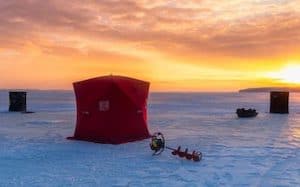
If you spend any amount of time on the ice, you’ll end up getting chilled to your bones due to exposure to winter weather without protection. This is especially true if you plan to ice fish at night, when it gets even colder.
A great way to deal with the subzero temperatures is by setting up a shelter on the ice, and fishing inside of it. The easiest (and cheapest) option is to set up a tent designed for this purpose, which is also relatively easy to transport on your ice fishing sled.
You can even heat the tent with a portable heater, which is usually propane powered, and guarantees toasty temperatures while it’s freezing cold outside.
If you’re fishing on one of the big lakes, such as Lake of the Woods in Minnesota, more permanent shelter solutions also come in handy. These can be ice shanties or even entire ice houses that are towed on to the lake, and that have beds, refrigerators, cooking facilities, etc..
You don’t need to set up a sleeper house yourself. Just find a good resort that rents them out – this is a great way to get to know ice fishing in a fun and convenient way.
Tip-ups
Tip ups are ice fishing devices designed to suspend a baited hook through an ice hole, and come with a bite indicator (usually a flag) that notifies you when a fish takes the bait.
And while tip-ups are not absolutely essential (especially if you’re a beginner), they can be super useful if you want to fish in several ice holes at the same time.
A popular tip up fishing strategy is to drill a series of holes around a promising location, and then set up tips with with live or dead bait on multiple holes, while actively fishing with a rod and a lure on another hole.
In essence, tip up ice fishing helps you to cover more water at the same time, and also enables you to test different depths and baits at the same time, until you find the winning combination.
Best ice fishing tackle for beginners
Now let’s talk about the fun stuff – the actual fishing tackle.
Ice fishing rod
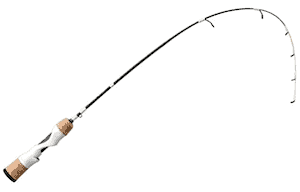
The most specialized part of ice fishing tackle is the ice rod, which is much shorter than regular rods.
While you can use a regular fishing rod for ice fishing, this is not an ideal solution, since regular rods are usually much too long to work well for this purpose (especially if you’re fishing inside a shelter).
On average, ice fishing rods are 28” to 36” long (for more details check our fishing rod length guide).
The shortest poles are around 20” to 24”, and are used for lightweight panfish fishing, while the longest ice rods go up to 48”, and these are used for large fish like pike and muskie.
During winter, fish are less aggressive in their feeding behavior compared to summer, and most species don’t grab your hook with force.
In fact, underwater camera footage of ice fishing regularly shows that most fish tend to approach a bait or lure very slowly and cautiously, and inspect if for a long time before deciding to bite.
This is where the short length of ice rods comes in really handy. It enables you to sit very close to your hole, so you can detect everything that goes on with your hook or lure straight below.
In fact, the lighter ice rod models are often held between the thumb and index finger (similar to holding a pen), which enables maximum sensitivity in detecting subtle bites.
There are many good brands of ice rods, and the cheapest ones start around $15, which makes them highly affordable for beginners who want to try out the sport.
Ice fishing reel
The are two main types of ice fishing reels:
- Spinning reels
- Inline reels.
Spinning reels
These are by far the most commonly used reel type for hardwater fishing. And in contrast to ice rods, you can use a regular spinning reel model for ice fishing.
But since ice rods tend to be smaller than regular fishing rods, the reels that pair with them also tend to be on the smaller side.
The most commonly used spinning reel sizes for ice fishing range from size 1000 to 3500, which covers the lightweight end of the scale.
Some manufacturers produce spinning reels that are specifically built for ice fishing, such as the Abu Garcia Ice Max.
Its two main distinguishing features are: first of all, the use of lubrication that doesn’t get solid at very low temperatures (called cold gear lube), and secondly, an extended reel stem, which makes it easier to hold the rod and reel between thumb and index finger.
Otherwise the overall design and build of spinning reels for hardwater fishing is more or less identical to regular spinning reels.
If you don’t want to go to the trouble of selecting a dedicated ice fishing reel, just go for one of the excellent ice fishing rod and reel combos on the market.
Inline reels
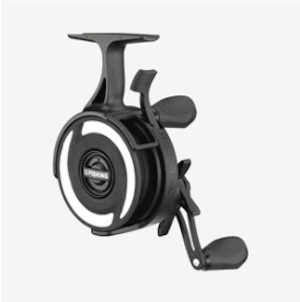
These have a very simple design, and were originally developed from fly fishing reels. But unlike fly reels, they have an extended reel stem, which allows the angler to hold the rod comfortably balanced between thumb and forefinger.
Inline reels tend to be smaller and lighter than spinning reels, and as a result are most popular for crappie and bluegill.
Inline vs spinning reels: which one is better?
What are the pros and cons of each reel type? In general, spinning reels are easier to use and much more versatile.
This means you can use the same model for cold season as well as warm season fishing, and during the winter, you can use it for a wide range of species, baits, and presentations.
Inline reels are almost exclusively used for ice fishing for panfish with jigs, so you should only get one if that’s something you really want to get into.
Finally, inline reels also tend to be more expensive than spinning reels. So overall, spinning reels are clearly the better choice for beginners.
Ice fishing electronics for beginners
There are two main types of electronics used for hardwater fishing:
- GPS
- Sonar
GPS tracking is present in most devices nowadays, but for ice fishing the most powerful use of GPS is when combined with lake mapping software like Lakemaster or Navionics.
These companies provide highly detailed lake maps of many locations, and this is especially useful for fishing on large lakes, since it enables you to locate the most promising spots quickly, instead of wasting countless hours with hole hopping.
Sonar is used to identify fish in the water column underneath your ice hole. In principle, you could use the same fish finder as you would in the summer, but this is not 100% ideal. Instead it’s much better to use a flasher, which is a fish finder specifically designed for vertical fishing.
There are two main features of flashers that make them ideal for ice fishing:
- Their transducer is attached to a float, which helps to position it precisely pointing down vertically, which is much harder to achieve with a regular transducer.
- They display their sonar signals as a single 1D column, which is perfect for interpreting what is going on in the water column right underneath your ice hole, while ignoring everything else.
In other words, flashers don’t mess around with fancy side imaging technology that you can get in regular fish finders, which is not really useful for hardwater fishing. Two of the best flasher brands are Vexilar and Marcum.
If you’re thinking about getting a flasher, be sure to have a look at our review of the best ice fishing flashers and fish finders.
Some high end fish finders have built in flasher functionality, which means you can use them either as regular fish finders, or as flashers (though you have to exchange the transducer to get the best results).
In some cases, they also include GPS with mapping functionality, so you can combine all of your ice fishing electronics in one device.
Ice fishing line
The two main types of fishing line used for hardwater fishing are:
- Monofilament
- Fluorocarbon
In contrast to warm season fishing, ice fishing line tends to be lighter. The reason for this is that many fish are finicky biters in winter, and tend to approach any bait very carefully.
Because of this, fluorocarbon is the most popular ice fishing line, since it has the lowest visibility underwater, helping to put cautious fish at ease.
The main disadvantage of fluorocarbon is that it is more expensive than monofilament (quite a lot more, actually). And since mono is largely fine for most purposes, it’s the best choice for beginners, due to the lower cost.
Ice fishing bait
There are three main types of ice fishing bait:
- Lures
- Live bait
- Dead bait
All three are very commonly used, and lures are actually often combined with live or dead bait.
Let’s take a look at each of these in more detail.
Ice fishing lures
Lures are great because you don’t have to get a fresh batch every time you go fishing. And if you choose the right lure and presentation, they can be at least as effective as worms or minnows.
Ice fishing lures are different from warm season lures because they are designed for vertical fishing. For example, many of them are attached to the fishing line in the middle of their back, while having hooks at both ends. This makes them perfect for a vertical presentation, unlike crankbaits or jerkbaits, which are designed to be retrieved horizontally.
Many of the best ice lures have a fluttering or darting sideways motion every time you raise or lower your rod tip, which is great for enticing predators to strike.
Here are some of the best types of ice fishing lures:
Jigging swimbaits
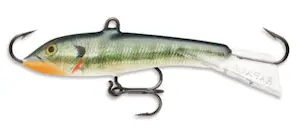
These are relatively small swimbaits attached to the line in the middle of their back. Famous examples are the Jigging Rap and Slab Rap, both made by Rappala. The Jigging Rap is one of the best performing ice fishing lures ever, and part of its success stems from its flattened tail region, which causes it to dart around like a wounded fish when you raise your rod. Especially walleye often find this irresistible, but it also works well on most other species.
Flutter spoons
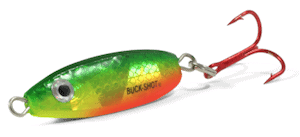
These are the secret weapon of many pike and perch anglers. The broad blade-like shape of these lures causes them to wobble back and forth in the water while lowered. And when combined with their metallic flashing colors, this makes them highly attractive for many fish.
Jigs
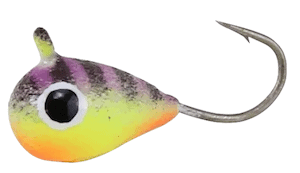
These are the most well known and most commonly used lures on the ice, which makes total sense, since they were originally developed for vertical fishing. Jigs come in a huge variety of sizes, colors and shapes. Some have a long plastic tail, while others don’t have any tail at all.
One of the advantages of jigs is that you can bait them with a whole minnow, a minnow head, or with a piece of worm or fish eye. This makes jigs incredibly versatile, since they enable you to combine the best of artificial lures and natural bait into one presentation. And unlike other lures, baiting a jig doesn’t impair its action in the water.
Some anglers even use baited jigs for deadsticking (deadsticking refers to a technique where you leave a rod unattended at an ice hole).
Natural baits
There are many kinds of natural bait used for ice fishing. Let’s take a look at the most commonly used ones, since these are the ones you should start with as a beginner.
Minnows: these are among the most commonly used ice fishing baits, and almost every tackle shop sells them. They are especially popular for targeting walleye and perch, and during winter time, minnows are by far the best live bait for walleye.
Minnows can be used either live or dead, or even just as a part of a minnow. A popular method is to bait a jig with a minnow head to use the scent and make it even more attractive to predators. When choosing the best minnow to use, try to stick to ones that exist naturally in the lake where you want to fish, or that at least look similar.
Mealworms: these make a great bait for trout and panfish, while the larger predators ignore them. The great thing about mealworms is that they are readily available in winter, since you can get them at tackle shops and pet shops everywhere.
Nightcrawlers: these can be hard to get in winter, but they are an absolute secret weapon for trout ice fishing. Pretty much every trout species, from rainbow trout to lake trout, goes nuts over nightcrawlers.
Try to keep the worms alive, so they will move around a little on the hook. When it comes to walleye, however, nightcrawlers don’t really work in winter (for more details, check out our article on do nightcrawlers work for ice fishing?
Wax worms: similar to mealworms these can be easily obtained in tackle shops and pet shops. Since wax worms are smaller than the other worm types, they can make a great choice for small panfish and perch. Some anglers also like to use them to on jigs for perch and trout.
Salmon eggs: these are a classic bait for all types of trout. On the great lakes they are one of the top performing options for catching trophy sized brown trout, but they work equally well on all other sizes and types of trouts.
Together with nightcrawlers, they are the best natural baits for trout in winter.
Bait fish (several species): while minnows are definitely the most popular type of bait fish for ice fishing, you can also use many other species (both dead or live, or even cut into pieces). A great way to determine which type of fish is best to use, look at the stomach content of freshly caught fish.
When it comes to northern pike and muskie in winter, it’s well known that they tend to prefer dead fish. So if you have been catching a lot of small perch, you can use the perch as bait and set up some tip-ups for pike.
Marshmallows: this is definitely an unorthodox bait for hardwater fishing, but in some cases you’ll only trigger bites if you do something unusual or different. Their texture, color and scent may elicit bites when nothing else will. Best used for rainbow trout.
Power bait: this is another option that can work well with trout, panfish, and perch. You can combine it with a jig or with worms.
Getting started: ice fishing essentials for beginners
Once you’ve got all your gear, fishing tackle, and bait ready, it’s time to hit the ice and start catching fish. As mentioned in the beginning, it’s best to do this with a guide or experienced angler if you are completely new to the sport.
Where to ice fish
The largest part of success in ice fishing boils down to drilling your hole in the right place. And actually, finding the best spots is a challenging topic that warrants a whole in-depth article on its own.
But to give you some actionable tips right now, try to look for transition zones in underwater structure, such as drop offs, reefs, hills, etc. The best way to find these is with a good lake map and a mapping device.
You can also use your flasher to check water depth at every hole you drill, plus you can refer to geographical features on the shore line, such as shore points and pinch points, and try to figure out how they affect nearby underwater topography.
If you’ve fished in the same lake during the summer, you can put your knowledge of structure to good use during the winter season. For example, if you know where bass like to hold in the hottest summer months, you’ll find them in the same spots during winter.
The best location also depends on the fish species you’re targeting and the time of day. For example, you’ll find panfish and yellow perch over shallow mudflats all day long, but walleye only tend to show up there just before nightfall.
Drilling a hole
This is where the auger comes into play. Whether you’re using a manual or a gas powered one, just follow the instructions that come with the auger.
How big should your ice hole be? The size of your ice hole needs to be sufficiently large for the species you want to catch. The diameter of the hole is determined by the size of the auger, and so you have to decide on the size before you buy it.
Here are the most common ice hole sizes, and what fish species they are good for:
- 6 inches: panfish, yellow perch
- 8 inches: northern pike, walleye, lake trout, bass
- 10 inches: muskie
If your ice hole is too small, you can enlarge it with a spud bar or small shovel. For more information on this topic, check out our article on how big should an ice fishing hole be?
Finally, how far apart should your ice fishing holes be? In general, you should take care not to drill your holes too close together. If you have two rods, or are fishing next to another angler, your holes should be at least 5-6 feet apart, so you don’t tangle your fishing lines while pulling up a fish.
Also, if you’re using an underwater camera, such as Aqua-Vu or Marcum, the ice hole of the camera should be at least 2 feet away from your fishing hole.
Again, this is to avoid a fish getting tangled in the camera cable when you pull it up. And actually, 2 feet is a little too close to avoid this completely, but it’s a compromise, since you need to be able to get close enough to get a good view with the camera.
Weather
Apart from the chill factor, weather also affects the feeding behavior of fish during the winter.
For example, on bright sunny days, it’s hard to get walleye to bite before sunset, while on overcast days, you can readily get walleye action even during the middle of the day.
In addition to the effects of lighting conditions, barometric pressure affects ice fishing. The best conditions tend to be just before a snow storm, when the barometric pressure drops rapidly.
Now let’s take a look at each of the most important species you can target with ice fishing.
Tips for the most commonly caught species
1. Ice fishing tips for panfish
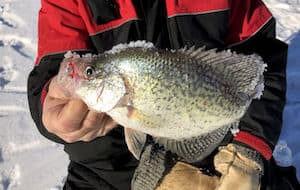
Panfish include bluegill, crappie, sunfish, and bream. Bluegill and crappie are among the most commonly caught fish during the winter season, and both are caught with similar methods
Where to find them: during early ice, panfish are mostly found on mudflats with weed growth, usually between 3-15 feet deep.
During mid winter, the weeds in the shallow areas die off due to snow on the ice blocking sunlight, and as a result the panfish move to deeper water.
At this time they are often found suspended in the middle of the water column, between 10 and 30 feet deep. Finally, during late ice, they move closer to the shore again, and can be found at transition points.
Behavior: panfish feed actively during the whole winter, but they feed less aggressively in the cold season, and tend to focus on smaller food sources, such as plankton.
How to catch them: due to their focus on plankton, it’s best to target panfish with ultra lightweight lures, such as micro jigs and tungsten jigs. A very successful strategy is to bait these with a waxworm, mealworm, or maggot. The movement of the jig attracts Panfish to investigate, and then the scent of the worms gets them to bite.
Since panfish are often suspended in mid-water, it’s extremely helpful if you can use a flasher to identify the correct depth to target. If this isn’t possible, lower your bait to the bottom, and then slowly pull it up one foot at a time, and then jiggle it for a while, until you feel a bite.
Once you catch a panfish, try to drop your hook down to the same depth again right away, as they usually stay together in schools, so you can expect to catch more of them right away.
2. Ice fishing tips for yellow perch
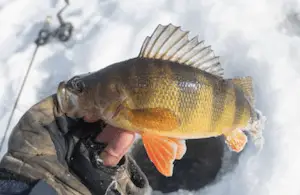
Next to panfish, perch are the most commonly caught fish during ice fishing.
Where to find them: small yellow perch up to about 5 inches in length are often found in large numbers together with schools of panfish on mudflats. But their larger counterparts, which can grow up to 2 pounds in weight, and 12-13 inches in length, frequent deeper water between 20 and 40 feet. During midwinter, they go even deeper, up to 50-60 feet deep.
Perch can be found close to structural transitions, similar to walleye, so on a larger lake you really benefit from a lake map to find those spots (e.g. river beds in reservoirs, underwater hills, points, etc.).
Behavior: similar to panfish and walleye, perch stick together in schools that consist of similar sized fish. In order to find a school, check promising locations with hole hopping and a flasher. Once you find a school, you’ll often catch fish after fish, since they like to feed aggressively.
How to catch them: rigging for perch ice fishing is similar to panfish, but one or two sizes larger (especially if you’re targeting jumbo perch). Small flutter spoons and jigs are great, and you can bait them with minnow heads, waxworms, or even with a single fish eye (perch eyes are great for catching bigger perch).
Lower your bait to the bottom, and then slowly raise it until you see fish marking it on your flasher. At that point it sometimes pays to pull up the jig rapidly for a few feet and then pausing, as this will trigger several fish to go after it and compete with each other.
3. Ice fishing tips for walleye
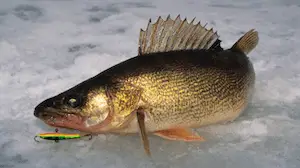
This is one of the most popular species for ice fishing, but walleye ice fishing can at times be tricky, especially on larger lakes without a local guide.
Where to find them: while most anglers assume that walleye are always found deep, this isn’t true.
During early ice you’ll find walleye on the same mudflats as schools of panfish and other small fish, which they are actively feeding on at this time.
During mid ice they retreat to deeper basins, walleye are often found around 20-40 feet deep, patrolling transition zones of underwater structures.
During late winter, walleye migrate towards their spawning grounds, which are river mouths and bays or inlets with gravelly bottom and tributary streams.
Behavior: similarly to perch, walleye also like to hunt in packs, but usually these groups aren’t as big as perch schools. Walleye received their name from their eyes, which are perfectly adapted for hunting in dimly lit conditions, and this is why their preferred feeding time is during the night, with a peak in activity at dusk (also known as the famous walleye evening bite).
For more details on this, check out our article on when do walleye bite best for ice fishing?
During the winter, they feed almost exclusively on small fish, but the preferred species can vary from location to location. In some lakes they hunt mainly shad, in other lakes it’s minnows or small perch. Once you know their preferred prey, you can try to figure out where their haunts are, since you can expect walleye nearby.
How to catch them: since the main food of walleye in winter are small fish, it’s no surprise that live or dead minnows are the top bait to use for them. However, another tactic that works well is to jig for walleye ice fishing with a small jigging lure, such as the Rapala Jigging Rap, or a jig baited with a minnow head, or a whole minnow.
For more details on this, check out our article on what is the best bait for walleye ice fishing?
When they are not feeding actively, walleye can be shy and hard to catch. In cases like that, a tactic that sometimes works well is to use several deadsticks with live or dead minnows, and to use one active rod which helps to attract the attention of walleye as they pass by. They’ll come in closer to investigate your lure, but then often decide to go for a minnow on one of your deadsticks.
4. Ice fishing tips for pike
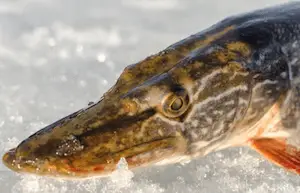
Pike, as well as their larger cousins muskie, are among the largest and strongest fish you can expect to catch on most lakes, and they are really fun to catch because they put up such a strong fight.
Where to find them: in early winter they are found close to mudflats with congregations of small fish, but as winter progresses, you’ll find them in deeper zones, often at transition points between deeper and more shallow areas.
Behavior: unlike walleye, pike are solitary hunters. So if you catch one, you usually can’t expect to catch another one right away. Instead, you may have to do hole hopping in order to find the next pike. Also, once a pike commits to your bait, it will strike it forcefully, which is much less subtle than walleye bites.
How to catch them: a great way to catch pikes on ice is by using big flashy spoons or extra large rattle baits presented in midwater. However, an even more effective strategy is by setting up a series of tips ups rigged with dead bait fish for pike.
This works especially well with fresh oily saltwater fish, such as herrings that produce a lot of smell. When you hook a pike, you can expect a hard fight, especially if it’s a big one north of 15 pounds.
If a big fish does explosive runs under the ice, it’s important to lower your rod tip down into the ice hole, so the line doesn’t chafe against the edge of the hole.
5. Ice fishing tips for trout
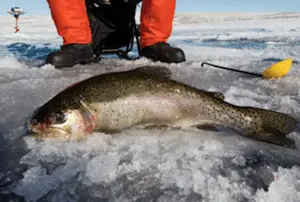
The most common trout species caught during ice fishing are rainbow trout (which are regularly stocked on many lakes), but you can also expect brown trout, brook trout and cutthroat trout, which all feed actively during the winter.
Where to find them: trout can be found at many depths, but most frequently in the top half of the water column near shoreline transition points.
Behavior: trout roam across a large area, patrolling for small fish and crustaceans. They usually roam alone, but sometimes also in small groups.
How to catch them: a great way to rig for trout ice fishing is to set up several deadsticks baited with nightcrawlers, waxworms, or salmon eggs suspended in midwater.
At the same time use a small flutter spoon on your active rod to attract roaming trout to come closer to investigate.
You’ll rarely get them to bite on your active rod, but more of them will go for the natural baits.
Always remember that trout hold higher in the water than many other species, so you also need to present your lure higher in the water column.
6. Ice fishing tips for lake trout
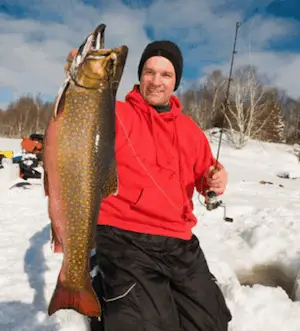
Big lake trout are among the most sought after ice fishing game fish, and they make great sport to catch, as they are strong and stubborn fighters.
Where to find them: expect them close to transition zones where there is a big change in depth between a shallow region and a deeper basin. They tend to hold to deeper water than other trout, and can often be found between 30 and 60 feet.
Behavior: similar to other trout species, they like to patrol large areas, but often travel in small groups. They are much more aggressive in their feeding behavior than other kinds of trout, which means you’ll have no doubt recognizing a strike.
How to catch them: just as for other trout species, you need to present your bait or lure in midwater, or even shallower than that. When a lake trout spots your lure from below, they can come up extremely fast to grab it. If you’re fishing with an artificial lure, present it in midwater, and periodically pull it up close to the surface.
Among the most effective lures for lake trout are jigging swimbaits and rattling lures. Feel free to choose sizes that are slightly larger than for walleye and perch. You can also use a single large minnow as bait.
When you’re fighting a big lake trout, remember to set a relatively loose drag to let them do their runs, and dip your rod tip into the ice hole to avoid line chafing against the edges.
Final remarks
This concludes our ice fishing beginners guide. Hopefully you’re feeling pumped, and ready to use the tips from our ice fishing for dummies guide to get out there to experience this wonderful sport first hand. Let me know how it goes, and if you love it just as much as I do. Tight lines and see you on the ice!
